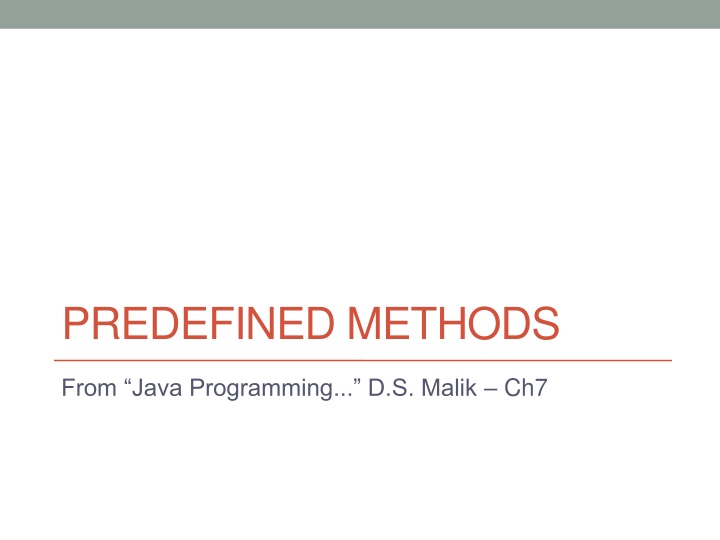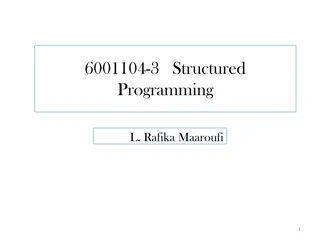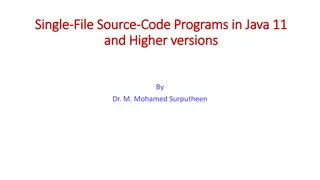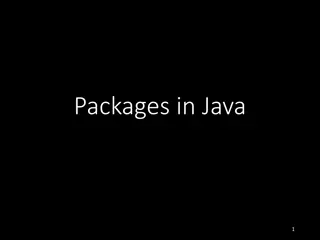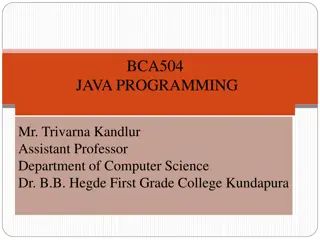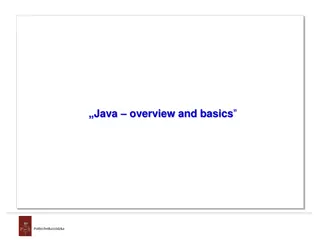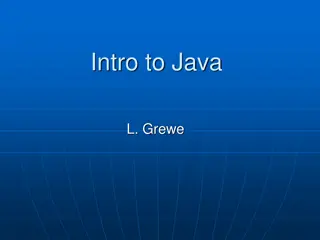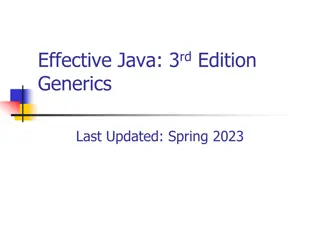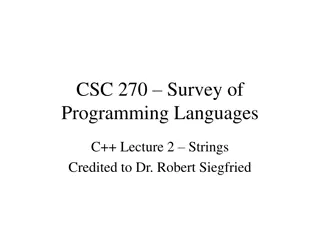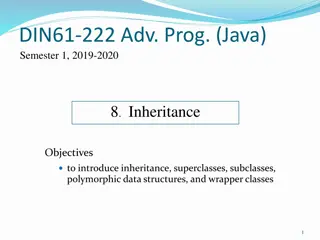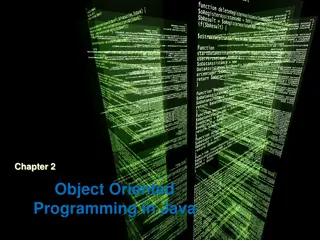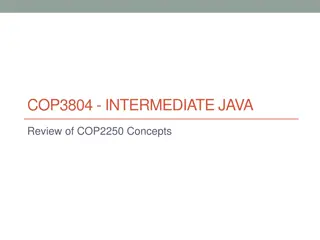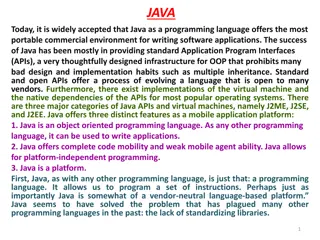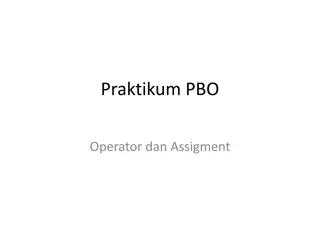Overview of Predefined Methods in Java Programming
Java programming involves the use of predefined methods organized in class libraries and packages. These methods can be readily used by importing the relevant packages. The presentation covers the concept of predefined methods, their usage with objects, and examples of popular methods such as nextInt(), nextDouble(), toUpperCase(), pow(), and more, highlighting their syntax and the classes they belong to.
Download Presentation

Please find below an Image/Link to download the presentation.
The content on the website is provided AS IS for your information and personal use only. It may not be sold, licensed, or shared on other websites without obtaining consent from the author.If you encounter any issues during the download, it is possible that the publisher has removed the file from their server.
You are allowed to download the files provided on this website for personal or commercial use, subject to the condition that they are used lawfully. All files are the property of their respective owners.
The content on the website is provided AS IS for your information and personal use only. It may not be sold, licensed, or shared on other websites without obtaining consent from the author.
E N D
Presentation Transcript
PREDEFINED METHODS From Java Programming... D.S. Malik Ch7
2 CSC111 Outline Introduction Mathematical Methods Character Manipulation Methods import static Statements 1. 2. 3. 4.
3 CSC111 Pre-defined methods A predefined method is an existing method that is written and provided by Java. In Java, predefined methods are organized as a collection of classes, called class libraries. Class libraries are stored in packages. The programmer can use a predefined method immediately after importing the relevant package. Example: nextInt(), nextDouble(), etc with Scanners equals( ), toUpperCase(), etc with Strings
4 CSC111 Pre-defined methods We have seen methods like these nextInt(), nextDouble(), etc with Scanners equals( ), toUpperCase(), etc with Strings , They were used with objects of those classes Syntax of a call: objectName.methodName(parameters)
5 CSC111 Pre-defined methods We will see methods like these pow(3,2), cos(theta), etc for class Math isDigit(ch), toUpperCase(ch), etc for class Character These do NOT need an object of those classes Syntax of a call: className.methodName(parameters)
6 CSC111 import statements All methods in this lecture belong to the package java.lang You have seen import statements like this: import java.util.*; We can have import statements like this: import java.lang.Math.*; But we will also see statements like this: import static java.lang.Math.* ;
7 CSC111 The Math Class Provides many standard mathematical constants and methods: double E = 2.7182818283590455; double PI = 3.141592653689793;
8 CSC111 The Math Class
9 CSC111 The Math Class Name Description Argument Type Return Type Example Value returned Returns the cosine of x (x is in radians) 1.0 1.0 cos(x) double double Math.cos(0.0) Returns the sine of x (x is in radians) 0.0 0.0 sin(x) double double Math.sin(0.0) Returns the tangent of x (x is in radians) Returns the value of ex; where e is approximately 2.718. 0.0 0.0 tan(x) double double Math.tan(0.0) 20.086 20.086 exp(x) double double Math.exp(3.0); 0.693 0.693 Returns the natural logarithm (base E) of x double double log(x) Math.log( 2.00) Math.log10 (1000.00) Returns the base 10 logarithm of x 3.00 3.00 double double log10(x)
10 CSC111 The Math.random() method Math.random()returns a random double that is greater than or equal to zero and less than 1, i.e., [0,1[ You can scale the result using addition and multiplication Example: the following simulates rolling a six sided die int die = (int) (6.0 * Math.random())+1;
11 CSC111 The Character Class
12 CSC111 Example 1 // assume you did: import java.lang.Character.*; String str = "I got\t30 cats.\n"; char oneChar; int i, ws=0, digits=0; for(i=0; i < str.length(); i++) { oneChar = str.charAt(i); if (Character.isWhitespace(oneChar)) ws++; else if (Character.isDigit(oneChar)) digits++; } System.out.println("the string: \"" + str +"\" has ws= " + ws + " digits= " + digits); System.out.println(Character.toUpperCase(str.charAt(2))); System.out.println(str.toUpperCase());
13 CSC111 Write a complete program that computes the length of a side of a triangle using the following formula: ?2= ?2+ ?2 2?? ??? The lengths of the sides b and c are given in cm. The angle is given in degrees.
14 CSC111 import static Statement For simplification, Java 5.0 introduces the following import statement: import static java.packageName.ClassName.*; After you include this statement in the program, you can omit the name of the class and the dot operator when calling a method.
15 CSC111 import static Statement For example: If you include: import static java.lang.Math.*; you can simply call abs(x) instead of Math.abs(x) If you include: import static java.lang.Character.*; you can simply call toLowerCase(ch) instead of Character.toLowerCase(ch)
16 CSC111 import vs importstatic 0 - 9 import java.lang.Math.*; public class MathTest1 { public static void main (String[] args) { int rand = (int)(Math.random()*10); double c60 = Math.cos(Math.PI/3); System.out.printf ( Random = %d and cos(60)= %f , rand, c60); }} //java.lang is the package; //Math is the class 1 2 3 4 5 6 7 8 What is the range produced? import static java.lang.Math.*; //java.lang is the package; // Math is the class public class MathTest2 { public static void main (String[] args) { double rand = (int)(random()*10); double c60 = cos(PI/3); System.out.printf ( Random = %d and cos(60)= %f , rand, c60); }} 1 2 3 4 5 6 7 8
17 3. PARSING NUMERIC STRINGS A string that consists of only an integer or a floating-point number is called a numeric string. A numeric string can contain a minus sign. Examples of numeric strings include: 2015 -20 144.45 -53.99 In order to process numeric strings as numbers (addition, multiplication, etc ), they must be converted first into numbers.
18 3. PARSING NUMERIC STRINGS Assume we have: String strExp1 = 2015 , strExp2 = -20 , strExp3 = 144.45 ; Integer.parseInt (strExpression) converts a numeric string to an int. o Integer.parseInt (strExp1) 2015 o Integer.parseInt (strExp2) -20 Float.parseFloat (strExpression) converts a numeric string to a float. o Float.parseFloat (strExp2) -20.0 (as a float) o Float.parseFloat (strExp3) 144.45 (as a float) Double.parseDouble (strExpression) converts a numeric string to a double. o Double.parseDouble (strExp2) -20.0 (as a double) o Double.parseDouble (strExp3) 144.45 (as a double)
19 CSC111 Parsing Example In this example we will read a line from the user in the format: name age height and then divide the whole string into three variables: name of type String, age of type Integer, and height of type double.
20 CSC111 Parsing Example import java.util.*; public class HelloWorld { public static void main(String []args){ Scanner input = new Scanner(System.in); System.out.println( Enter your name, age, and height: ); String str = input.nextLine(); int first_space = str.indexOf(" "); int second_space = str.indexOf(" ",first_space+1); String name = str.substring(0,first_space); int year = Integer.parseInt(str.substring(first_space+1,second_space)); double height = Double.parseDouble(str.substring(second_space+1)); System.out.println(name + " will be " + (height+2.0)+ " tall when he turns " +(year+1)); } // end main } // end class
21 CSC111 Use the Java built-in methods to compute the roots of a quadratic equation in x of the form: ax2 + bx + c = 0. The two roots are defined as: ?+ ?2 4?? 2? root1 = ? ?2 4?? 2? root2 =
